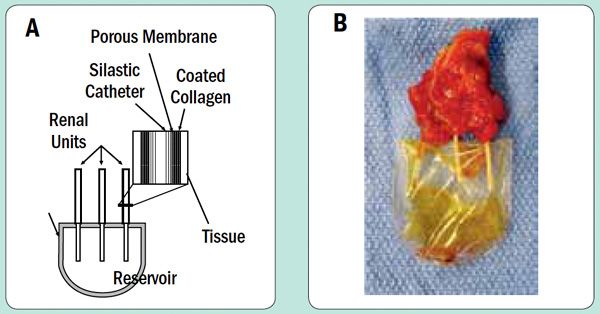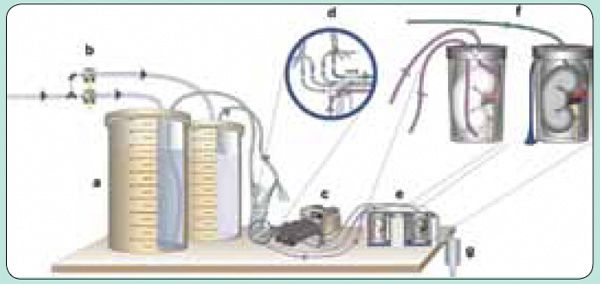Article
Regenerative medicine for the kidney: How far we've come
This article discusses the role of transplantation of embryonic renal structures, two forms of scaffolds, and the role of various stem cell populations in regenerative medicine.


David S. Koslov, MD Anthony Atala, MD
Dr. Koslov is a urology resident at Wake Forest Baptist Medical Center, and Dr. Atala is director of the Wake Forest Institute for Regenerative Medicine and professor and chair of the department of urology at Wake Forest University, Winston-Salem, NC.
Renal transplantation faces severe donor shortages. With the United Network for Organ Sharing estimating that 95,052 candidates were on the waiting list for kidney transplants with only 9,819 donors in 2012, our ability to provide transplants is very limited by supply. Regenerative medicine strives to provide an alternative to dialysis and live/deceased donor transplantation. Advances in direct transplantation of renal precursors, biomaterials, and stem cells over the past several years have brought regenerative medicine for the kidney closer to patient care (Bioengineered Kidney and Bladder. In: Encyclopedia of Human Biology. Oxford: Elsevier; 2012).
This article discusses the role of transplantation of embryonic renal structures, two forms of scaffolds, and the role of various stem cell populations in regenerative medicine.
Renal precursors
Early studies in renal regeneration were based in transplanting embryologic structures to replace lost kidney function. Several groups worked on transplanting immature metanephroi, both allogeneic and xenogeneic, in animal models (figure 1). These studies found that transplanted structures could grow and produce urine in renal and extra-renal locations, evade host rejection, recruit vasculature, and fulfill endocrine roles of the kidney (Lab Invest 1991; 64:629-39; Kidney Int 1998; 54:27-37; Organogenesis 2004; 1:22-5). Even human metanephroi have been shown to grow and produce urine in immunodeficient mice (Nat Med 2003; 9:53-60).

Illustration shows renal precursors derived from nuclear transfer, attached to a synthetic renal device, and reimplanted in nuclear donor animals (A). Units grew, formed glomeruli and tubules with appropriate orientation, and produced urine-like fluid (B). Reprinted with permission from Nat Biotechnol 2002; 20:689-96).
As use of this experimental approach expanded, understanding of its potential benefits did as well. In 2012, researchers demonstrated that transplanted metanephroi increase blood pressure in an induced hypotension rat model (Nephrol Dial Transplant 2012; 27:3449-55), increase erythropoietin levels in anemic rat and feline models (Stem Cells 2012; 30:1228-35), and significantly decrease thoracic aorta calcifications in a rat chronic kidney disease model (NephronExp Nephrology 2012; 120:e32–e40). Transplanting embryonic renal structures may ultimately play a key role in recovering renal loss in patients in the future, either by replacing nephrons or serving as a scaffold for stem cells.
Scaffold development
Alternative approaches to regenerative medicine for the kidney include use of a scaffold and stem cell populations to generate a functional kidney. We examine two scaffolds types and the role of certain stem cells in regenerative medicine.
Decellularized kidney. Due to the complex anatomy of the kidney, decellularizing a formed organ while preserving vascular and parenchymal anatomy has been a sought-after approach for regenerative medicine. Success with decellularization of rat (J Am Soc Nephrol 2009; 20:2338–47), monkey (Tissue Eng Part A 2010; 16:2207-16), and pig kidneys with ionic and nonionic detergents make this a promising approach. If done correctly, the residual extracellular matrices will provide niches for cell growth and signaling capacity to guide stem cell differentiation. Optimal decellularization techniques would rapidly remove all native cells while maintaining organ structure and matrix integrity.
Recent contributions to this field came from several groups: Orlando et al showed that decellularized porcine kidneys could be reimplanted unseeded in live pigs and maintain renal structure after 2 weeks in vivo (Ann Surg 2012; 256:363-70). Sullivan et al compared two detergents in a high-throughput system, ultimately finding that 0.5% sodium dodecyl sulfate (SDS) could optimize cell removal and maintain kidney architecture (figure 2) (Biomaterials, 2012; 33):7756-64). And Ofenbauer et al introduced an efficient method to analyze decellularizated tissue repopulation using thin cuts of deparrafinized ECM and RT-PCR (J TIssue Eng Regen Med Nov. 22, 2012 [Epub ahead of print]). Use of decellularized renal structures as a scaffold for cell repopulation shows promise as a potential method of renal replacement to meet the increasing transplant demand.

Porcine kidney decellularization process is demonstrated with a) detergents being diluted with b) deionized water and c) pumped through d) three-way valve delivery system into the e) scaffolds. Fluids enter in through f) the artery and are g) drained. Reprinted from Biomaterials 2012; 33:7756-64, with permission from Elsevier.
Bioprinting. An alternative to organism-derived scaffolds for renal regenerative medicine is printing the organ de novo. In this approach, 3-D scaffolds are manufactured using computer and modified printer-based technology to create porous structures where selected cells will expand and form a functional organ. To optimize this technique, groups have used various “ink” gels with and without cells to design these structures. Two printer-based techniques have been studied: inkjet printing where cells or clusters are printed, and mechanical extruders where cell aggregates are laid in units.
Inkjet printing is a quick and efficient way to develop tissues, but a challenge to ensure that appropriate cell density for organ generation is attained, and many cells are damaged in this process (Expert Opin Biol Ther 2007; 7:1123–7; Biotechnol Bioeng 2010; 106:963–9). Mechanical extruders place cells in aggregates, which helps in cell signaling and development. This approach is much more expensive, but has the advantage of being able to print complex structures (Tissue Eng 2006; 12:1325–35). In 2012, Imani et al showed advancements in optimal bio-inks (Biocell 2012: 36:37-45), and Xu et al defined a hybrid of inkjet technology to improve cartilage printing (figure 3) (Biofabrication Nov. 21, 2012 [Epub ahead of print]). As most of the bioprinting is in prototype stages, transferring these technologies to patient care will take time. Concerns for immune rejection and infection will have to be addressed as well.

Hybrid inkprinter for printing bioengineered cartilage in A) graphic and B) actual form. Reprinted from Biofabrication Nov. 21, 2012 (Epub ahead of print) with permission from IOP Publishing.
Cells for regeneration
Various cells can be chosen for renal regenerative medicine, including fetal, adult, and reprogrammed stem cells. Each offer unique advantages.
Embryonic. For the purpose of renal regeneration, embryonic stem cells have proven to be challenging targets. While Ross et al had success with decellularized rat kidneys repopulated with murine embryonic stem cells that expanded, differentiated, and remodeled the rat scaffold (Organogenesis 2012; 8:49–55), fetal cells destined to become kidney residents may require less cues for organ engineering. It is known that multipotent renal precursors existed in metanephric mesenchyme, but techniques to isolate and expand these cells have been challenging (Development 1992; 114:565-72). In 2009, Orit Harari-Steinberg identified cells expressing NCAM+EpCAM- and NCAM+EpCAM+ from human embryonic kidney that seemed to meet this profile, offering a potential source of cells for regeneration (PLoS One 2009;4:e6709). Harari-Steinberg’s and other groups continue to work on isolation and expansion of these cells for regenerative purposes. However, the ethics of research using human embryos continues to be a concern.
Induced pluripotent cells. Induced pluripotent stem (iPS) cells have rapidly been incorporated into research for several fields in medicine, including islet cell and motor neuron studies (J Biol Chem 2008; 283:31601-7; Stem Cells 2009; 27:806-11). Inducing renal lineage cells from iPS has also been successful by using similar growth factors and cytokines as those used to induce embryonic stem cells (Semin Nephrol 2012; 32:479-85). Promising advances in iPS use came when Usui et al transplanted murine iPS into Sall1 (Sal-like protein 1) knockout mouse blastocysts unable to undergo renal organogenesis, and noted that the newborn mice had kidneys primarily of donor origin, while the vasculature was a chimera of donor and host (Am J Pathol 2012; 180:2417–26). While advantages to using this cell population include circumvention of both ethical concerns and immunologic rejection, we are still in the early phases of understanding their potential. The relative novelty of iPS and concerns over introducing potential oncogenes SOX-2, OCT-4, and c-MYC into cells to create iPS makes the utility of these cells uncertain for patient care.
Adult. Perhaps the most difficult cell to work with for renal regeneration is the adult progenitor stem cell. In contrast to the gastrointestinal tract or integument, which are constantly regenerating, identifying a stem cell population for the kidney has proven difficult. In fact, there is no concrete demonstration of neonephrogenesis, or new nephron formation in the adult. It is well known that the kidney recovers from acute injury with the ability to repair damaged nephrons, but identification of the cells responsible for this recovery is controversial. Several studies using BrdU, a marker of slowly dividing cells, have proposed that a subset of CD133+ cells located in several sites within the organ may fulfill this role; they bear several markers of stem cells, self renewed in culture, and improved glomerular form and function when exogenously administered to glomerular injury models (J Am Soc Nephrol 2006; 17:2443-56; J Am Soc Nephrol 2009; 20:333-43; Biochim Biophys Acta 2011; 1812:1344-57). Certainly, making use of adult committed progenitor cells in regenerated renal tissues is enticing and may prove key in renal regenerative medicine.
More completely understood for their role in kidney repair are the mesenchymal stem cells (MSC). These bone marrow-derived cells are multipotent and have demonstrated renoprotection in several models of acute kidney injury. They have been shown to increase in number after acute renal insult, localize to the organ, and deliver microvesicles in a paracrine manner that provide renoprotection without fully integrating in to the organ (Blood 2005; 105:1815-22). While knowledge of MSC is more complete, both adult cell types merit further investigation.
Conclusion
Our current ability to provide renal transplantation for our patients in end-stage renal disease is insufficient to account for the ever-increasing number of patients on waiting lists. Regenerative medicine offers an alternative to live or deceased donor kidneys. Large steps have been made in our knowledge of embryonic renal structures, biomaterials, and stem cells, all of which may play a key role in renal regenerative medicine in the future.UT
Newsletter
Stay current with the latest urology news and practice-changing insights — sign up now for the essential updates every urologist needs.

















